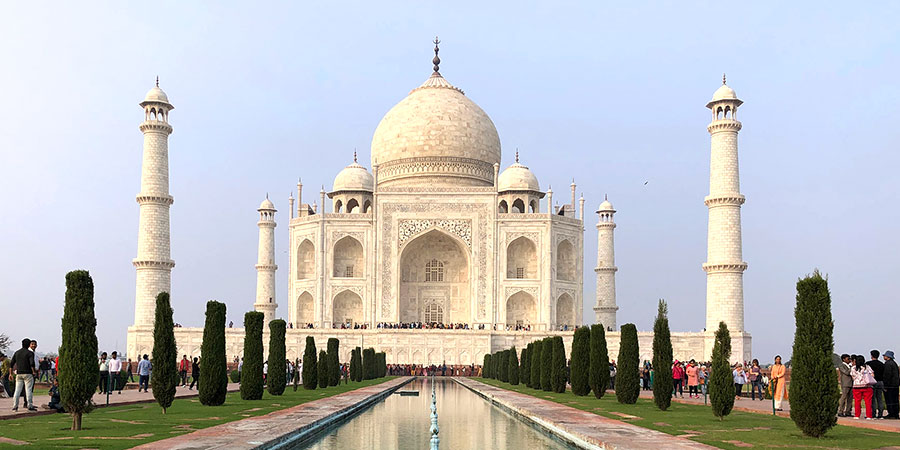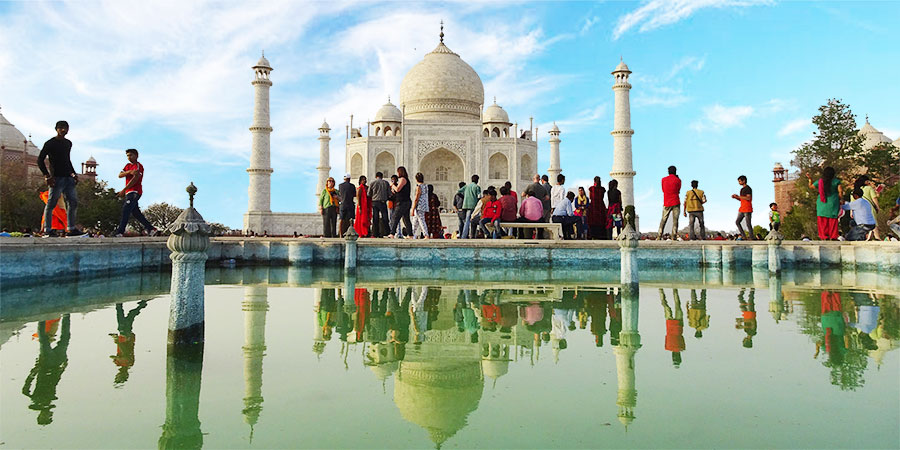Taj Mahal – A Tomb That Changed the History of India
Highlights on Agra Taj Mahal
![]() Address: Dharmapuri, Forest Colony, Tajganj, Agra, Uttar Pradesh 282001
Address: Dharmapuri, Forest Colony, Tajganj, Agra, Uttar Pradesh 282001
![]() Taj Mahal Timings: Open from sunrise and sunset (Friday closed)
Taj Mahal Timings: Open from sunrise and sunset (Friday closed)
![]() The Time Required: Usually, two to three hours
The Time Required: Usually, two to three hours
![]() Taj Mahal Ticket Price (for foreigners): INR 1,100 (additional INR 200 for main mausoleum entry) – Entry for children below 15 years is free (both domestic and international)
Taj Mahal Ticket Price (for foreigners): INR 1,100 (additional INR 200 for main mausoleum entry) – Entry for children below 15 years is free (both domestic and international)
![]() Best known: Stunning architecture
Best known: Stunning architecture
![]() How to Get to Taj Mahal: Agra is accessible via roads, railways, and airways – After reaching Agra, visitors can board an auto-rickshaw or taxi to reach Taj Mahal location.
How to Get to Taj Mahal: Agra is accessible via roads, railways, and airways – After reaching Agra, visitors can board an auto-rickshaw or taxi to reach Taj Mahal location.
Commissioned by Shahjahan (the third Mughal ruler), in the memory of his beloved wife – Mumtaz Mahal, the monument is considered as the eternal symbol of love. The magical appeal of this stunning monument showcases the glorious legacy of the Mughal architecture. As you cross the stunning marble edifice and the peaceful mausoleum, you can feel the undying love of the emperor for his beloved wife. This write-up focuses on helping you in discovering this stunning monument.

|
Why was the Taj Mahal built? – A brief glimpse at the Taj Mahal history
According to the records retelling the Taj Mahal story, the third Mughal ruler Shah Jahan commissioned an iconic building in the memory of his queen who died during childbirth. The imperial documents mention that the king was grief-stricken after the death of his wife, so much so that, it is said his hair had turned grey suddenly.The official documents further point out, that the king appointed Ustad Ahmad Lahauri as the architect of Taj Mahal. He took inspiration from the existing Mughal and Indian themes and buildings and designed a monument. The outcome of this was a building that was not only lavish but also had an inherent class and sophistication – making it worthy of the Queen of India.
The construction of the Taj Mahal began in 1632, just a year after the queen’s death, and took close to two decades to complete the entire complex. Interestingly, just a few years after the completion of the monument, the Mughal emperor witnessed a coup d'état from his son Aurangzeb and imprisoned for life. It is said that the emperor, during his days of captivity would observe this magnificent monument from his window.
After his death, Shah Jahan was buried next to Mumtaz Mahal, where he was reunited with the love of his life.
|
|
|
The architecture of Taj Mahal
Since the answer to who built Taj Mahal has already been provided, we will focus on the architecture of this stunning building. Constructed in the 17th century, the Taj Mahal incorporates ideas from archetypal Persian monuments and Indian architecture. It is believed that Ustad Ahmad Lahauri took inspiration from all the places like the tomb of Timur in Samarkand, Humayun's Tomb, and a host of other places. The use of marble with in-laid work was promoted by the emperor himself, giving this monument an elegant but modern look.
Garden area and the surrounding monuments

Taj Mahal
|
Night tour of Taj Mahal
Night tours of the Taj Mahal are most anticipated among the tourists. On five days in any given month, the monument could be viewed during the night. These days are:1. Two nights before Full Moon
2. The Full Moon night
3. Two days after the Full Moon night
Visitors can book the tickets one day before the event. The viewing is held in eight sessions, lasting half an hour. These sessions begin from 10.30 pm and last till 12.30 pm. Visitors have to report at least 30 minutes early before their viewing time. Since tickets are limited, you have to be swift in booking the tickets. Also, during the holy month of Ramadan, the night viewing is closed, so plan your trip accordingly.
The ideal time to visit Taj Mahal
Since the Taj Mahal location and history attracts numerous tourists from different corners of the world, the place is usually swarming with vacationers. For a peaceful viewing experience visit the monument during sunrise or sunset.Frequently asked questions
1. Where is the Taj Mahal?
Agra, India2. Distance from Delhi
The distance between the Taj Mahal from Delhi is close to 250 kilometers (155 miles), which can be covered in four hours. The Taj Express Highway could be chosen for the trip.
Read more about How to Travel from Delhi to Taj Mahal
3. Nearest Airport and Railway station
Airport: Agra Airport (domestic) and Indira Gandhi International Airport (international)Railway station: Agra Fort Railway Station
4. Ticket Counter
Tickets could be purchased from the Western and Eastern Gate of the monument. Southern Gate is used for exit.
You May Like:
Taj Mahal's Rules & Regulations
What to Do in Agra beyond the Taj Mahal
9 Romantic Things to Do in Taj Mahal




